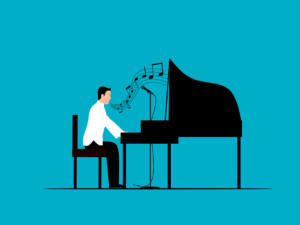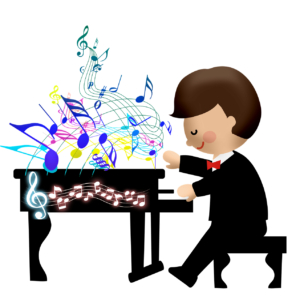Estimated reading time 3 minutes
Table of Contents
Introduction
Want to be able to sing in tune every time you sing? Do you wonder what a touch instrument is? These instruments play a central role in establishing the tuning for a society. Keep reading to learn how to sing perfectly in tune all the time with touchstone instruments.
This article uses music terms. For definitions, see the Glossary at the end of the post.

Sing Perfectly in Tune All the Time with Touchstone Instruments #1: What’s a Touchstone Instrument?
“How can I learn to sing perfectly in tune all the time with touchstone instruments?” We learned in the post Harmony and Melody Tune Differently that melody is the relationship of remembered pitches taking place over time.
Since tuning a melody relies on memory, culture has a big impact on what’ll be in tune.
- As I studied the ethnomusicology literature, I began to see a pattern that led to the concept of touchstone instruments.
- All cultures around the globe have both fixed and flexible pitch instruments.
- Touchstone instruments consist of fixed pitch instruments that provide melodic or harmonic sound models (or both).
- These instruments influence a singer’s mental pitch template.
For example, when I sang in chorus, the first thing I’d do would be to go to the practice rooms and play the piano.
- I’d bang out the notes until I got them in my ear.
- Thus, playing the piano helped me to remember the melodies.
- The piano is a good sound model for melodic tuning, because it’s the model for melodic tuning in Western culture.
- However, it won’t be a good model for harmonic tuning.
- Stated another way, the piano acts as the default melodic sound model for singers and will also be the de facto harmonic sound model.
- However, the piano won’t foster a cappella level harmonic intonation.

Sing Perfectly in Tune All the Time with Touchstone Instruments #2: Can the Piano Help?
Let me tell you a story. Years ago, I taught in a music school. On Tuesdays a vocal teacher did lessons next to my room, and one of her students had issues with pitchiness. My piano student would wince every time the vocalist hit a wrong note. The piano student hadn’t studied voice, yet her experience playing piano helped her to hear when the notes sounded wrong.
This means that you can learn to sing perfectly in tune all the time with touchstone instruments. However, it won’t happen overnight after taking a few vocal lessons. It takes years of practice.
If you want to sing classical or pop, the piano can help you sing melodies in tune:
Learning harmony will be more difficult because we don’t have touchstone instruments for that… at least until now. This link will take you to posts with specially tuned sing-along soundtracks that’ll act as touchstone instruments, helping you learn how to harmonize in tune:

Sing Perfectly in Tune All the Time with Touchstone Instruments #3: What About Other Cultures?
Touchstone instruments are important because they reveal how people tune in a particular culture.
So, studying touchstone instruments from around the world will reveal how melodic and harmonic sound models affect vocal intonation.
- This doesn’t mean that “in tune” will be the same for all cultures.
- For example, when I rented a room during college a few of my house mates came from Greece.
- One of the guys loved to sing. To me, his melodies sounded off, but one of the other Greek guys said, “He sings so well.”
- Only later did I realize that his singing likely had at least some middle eastern influences because of Greece’s cultural history.
- So, not all music can be judged by the same standard, which also means that one culture’s touchstone instruments may be tuned differently than another’s.
In part 2, we’ll look at some touchstone instruments from other cultures. This means you’ll be able to learn how to sing perfectly in tune all the time using the touchstone instruments from your own culture.
Have fun singing!
The “10 Elements that Impact Singing in Tune” Posts
- 10 Elements that Impact Singing in Tune
- Harmony and Melody Tune Differently
- Vibrato Impacts Singing in Tune
- A Harmony’s Length Impacts Singing in Tune
- Harmony Is Tone Color
- A Note Contains Many Pitches
- Singing in Tune with Vowels
- How Intervals Affect Singing in Tune
- Is There a Difference in Difficulty for Performing Specific Vowels?
- Can I Learn Singing on the Piano?
© 2023 Geoffrey Keith
Join me for in-person or online lessons today!
Glossary
How Do Musicians Find Enough Time to Practice Their Instruments?
“How do musicians find enough time to practice their instruments?” It can be challenging. Adults live busy lives, and kids have tons of homework, sports, and afterschool activities. However, it’s not hopeless. You just have to learn how to best structure the time you have. Keep reading to find out how it works. Estimated reading time 2 minutes.
Read MoreSinging 7th Chords in Tune
Do you have a hard time singing 7th chords in tune? Most vocalists do. Don’t worry, the sing-along song tracks can help! Read more to learn how. Estimated reading time 3 minutes.
Read MoreWhat’s the Deal with These i-VII-VI-V and iv-V-VII Chords and Stuff? (Part 4)
Do your eyes cross when you try to figure out Roman Numeral analysis? Roman numerals are broadly used to analyze chords in songs. However, you’ll use some Roman numerals to specifically describe harmonies in minor keys. Read more to find out the answer to, “What's the deal with these i-VII-VI-V and iv-V-VII chords and stuff?” Estimated reading time 3 minutes.
Read MorePlaying Piano with Color Coded Left Hand Notes
Are you having a tough time reading piano notes for the left hand? (Or are you a piano teacher who has students that can’t read the left hand notes?) Many piano students quit piano because of the hurdle of reading two different clefs. Color coding can bridge the gap and help piano students master the instrument. Read more to learn about playing piano with color coded left hand notes. Estimated reading time 3 minutes.
Read More




